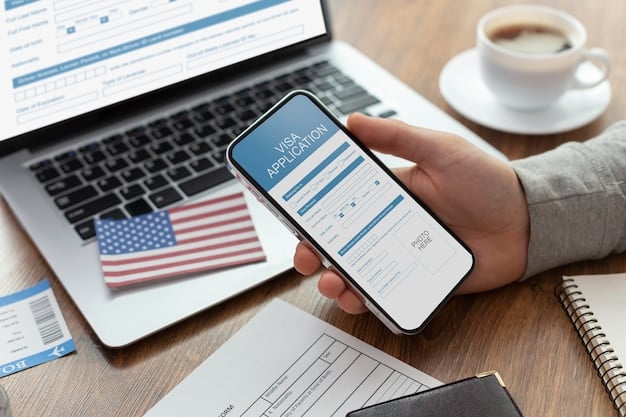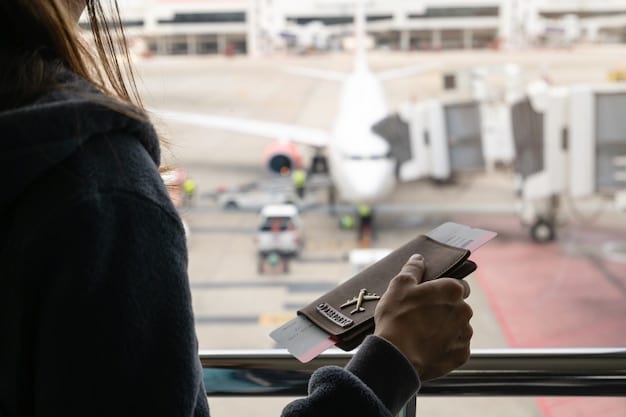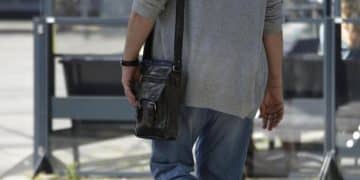Lost or Stolen Passport: Immediate Steps to Minimize Damage

If you’ve lost your passport or had it stolen, the immediate steps to minimize the damage involve reporting the loss or theft to the State Department and local police, and then applying for a replacement passport to ensure you can continue your travels or return home.
Discovering your passport is missing can be a travel nightmare. Whether it’s lost or stolen, knowing what to do immediately is crucial to minimize the damage and hopefully salvage your trip. The initial panic can be overwhelming, but by taking swift and decisive action, you can mitigate potential risks and start the process of obtaining a replacement. Let’s walk through the essential steps you need to take if you’ve experienced a lost or stolen passport: what to do immediately to minimize the damage.
Report the Loss or Theft Immediately
The very first thing you should do upon realizing your passport is missing is to report it. Timely reporting is critical for preventing potential identity theft and misuse of your passport. This should be done with both local authorities and the U.S. Department of State.
Report to Local Police
File a police report in the area where you suspect the passport was lost or stolen. This report serves as an official record of the incident, which can be helpful for insurance claims and when applying for a replacement passport. Make sure to get a copy of the police report for your records.
Report to the U.S. Department of State
Next, report the loss or theft to the U.S. Department of State. This can be done online or by phone. Reporting the issue to the State Department ensures that your missing passport is invalidated immediately, preventing anyone else from using it. You can report it through the following:
- Online: Use the State Department’s online reporting tool to quickly submit the information.
- Phone: Call the National Passport Information Center to report the incident over the phone.
- In-Person: If you’re near a U.S. embassy or consulate, you can report it in person. This is particularly useful if you need immediate assistance with obtaining a replacement passport.
Reporting the loss or theft to both the local police and the U.S. Department of State is crucial. This dual reporting ensures that your passport is properly invalidated, reducing the risk of identity theft or misuse.

Gather Necessary Documentation for Replacement
Once you’ve reported the loss or theft, the next step is to gather all the necessary documentation to apply for a replacement passport. Having these documents ready will streamline the application process and help you obtain your new passport as quickly as possible. Here’s what you’ll need:
Proof of U.S. Citizenship
You’ll need to provide proof of your U.S. citizenship. Acceptable documents include:
- A certified birth certificate
- A previous U.S. passport (if available)
- A Certificate of Citizenship or Naturalization
If you don’t have immediate access to these documents, try to obtain copies as soon as possible. You may need to contact the relevant vital records office or the National Archives.
Identification
You’ll also need a valid form of identification, such as:
- A driver’s license
- A state-issued ID card
- A military ID card
Make sure your ID is current and has your photo on it. If your ID has expired, you’ll need to renew it before applying for a replacement passport.
Passport Photos
You’ll need two identical passport photos that meet the U.S. Department of State’s requirements. These photos must be:
- 2×2 inches in size
- In color
- Taken within the last six months
- Taken against a white or off-white background
Many pharmacies and photo studios offer passport photo services, making it easy to obtain compliant photos quickly.
DS-11 Form
You’ll need to complete Form DS-11, the Application for a U.S. Passport. You can download this form from the U.S. Department of State’s website or pick it up at a passport acceptance facility. Fill out the form accurately and completely, ensuring all information is correct.
Gathering all the necessary documents before you start the replacement process ensures a smoother and faster experience. Double-check that you have everything required to avoid delays.
Expedite the Replacement Process
Depending on your travel plans, you may need to expedite the replacement process to get your new passport as quickly as possible. There are several options available to speed things up. Understanding these options and choosing the right one for your situation can save you valuable time and stress.
Apply in Person at a Passport Agency
If you have urgent international travel plans, you can apply in person at a regional passport agency. To do this, you’ll need to schedule an appointment and provide proof of your travel plans, such as a flight itinerary. Applying in person can significantly reduce processing times.
Use Expedited Processing
When applying for a replacement passport, you can request expedited processing. This service costs an additional fee but can shorten the processing time to a few weeks. Be sure to include the expedited service fee when submitting your application.
Contact Your Congressional Representative
Another option is to contact your congressional representative for assistance. Congressional offices often have staff members who can help expedite passport applications, particularly in urgent situations. Reach out to your representative’s office and explain your situation.
Consider a Passport Expediting Service
There are private passport expediting services that can help you obtain a replacement passport quickly. These services often have relationships with passport agencies and can navigate the process more efficiently. However, be prepared to pay a premium for their services.
Expediting the replacement process can be crucial if you have upcoming travel plans. Evaluate your options carefully and choose the method that best fits your needs and timeline.

Protect Yourself from Identity Theft
When a passport is lost or stolen, the risk of identity theft increases significantly. Taking proactive steps to protect yourself is essential to prevent potential fraud and financial harm. Here’s what you can do:
Place a Fraud Alert on Your Credit Reports
Contact one of the three major credit bureaus (Equifax, Experian, and TransUnion) and place a fraud alert on your credit report. This alert requires creditors to verify your identity before issuing credit in your name. The credit bureau you contact is required to notify the other two.
Monitor Your Credit Reports
Regularly monitor your credit reports for any suspicious activity. Look for unauthorized accounts, unfamiliar transactions, or any other signs of fraud. You can obtain free copies of your credit reports from AnnualCreditReport.com.
File an Identity Theft Report with the FTC
Report the identity theft to the Federal Trade Commission (FTC). This report can help you dispute fraudulent charges and correct inaccuracies on your credit reports.
Be Cautious of Phishing Scams
Be vigilant about phishing scams, which may target you after your passport is lost or stolen. Scammers may try to obtain your personal information by posing as government officials or financial institutions. Never share sensitive information over the phone or via email unless you are certain of the recipient’s legitimacy.
Consider Identity Theft Protection Services
Consider enrolling in an identity theft protection service, which can provide additional monitoring and alerts. These services typically offer features such as credit monitoring, fraud alerts, and identity restoration assistance.
Protecting yourself from identity theft is an ongoing process. By taking these steps, you can minimize the potential damage from a lost or stolen passport.
Emergency Travel Options
If you need to travel urgently and cannot wait for a full replacement passport, there are a few emergency travel options to consider. These options may allow you to travel temporarily while you wait for your new passport to be issued.
Emergency Passport
In certain emergency situations, such as a medical emergency or the death of a family member, U.S. embassies and consulates can issue an emergency passport. These passports are typically valid for a limited time and may restrict your travel to specific destinations. Contact the nearest U.S. embassy or consulate to inquire about obtaining an emergency passport.
Contact the Nearest U.S. Embassy or Consulate
If you are stranded in a foreign country without your passport, contact the nearest U.S. embassy or consulate for assistance. They can provide guidance on obtaining emergency travel documents and other support services.
Travel on Other Forms of Identification
Depending on your destination and circumstances, you may be able to travel on other forms of identification, such as a driver’s license or a state-issued ID card. Check with your airline and the relevant immigration authorities to determine if this is possible.
Apply for a Temporary Passport
Some countries offer temporary passports or travel documents to U.S. citizens who have lost their passports. These documents are typically valid for a short period and may only allow travel to specific countries. Contact the embassy or consulate of the country you wish to visit to inquire about this option.
Emergency travel options can provide a temporary solution if you need to travel urgently. However, it’s essential to start the process of obtaining a full replacement passport as soon as possible.
Prevention Tips for the Future
Preventing passport loss or theft is always better than dealing with the aftermath. Taking a few simple precautions can significantly reduce the risk of losing your passport. Here are some tips to keep your passport safe and secure:
Make a Photocopy of Your Passport
Before you travel, make a photocopy of your passport’s information page. Store the photocopy separately from your actual passport. This can be helpful for identification and when applying for a replacement passport.
Store Your Passport Securely
When you’re not using your passport, store it in a secure location, such as a hotel safe or a hidden compartment in your luggage. Avoid carrying your passport in your back pocket or leaving it unattended.
Use a Passport Holder or Wallet
Consider using a passport holder or wallet designed to protect your passport from damage and theft. These holders often have RFID-blocking technology to prevent electronic theft of your passport information.
Be Aware of Your Surroundings
Be aware of your surroundings and take precautions to avoid pickpockets and thieves. In crowded areas, keep your passport close to your body and avoid displaying it unnecessarily.
Consider a Digital Copy
Keep a secure digital copy of your passport on your phone or in a cloud storage account. Make sure the copy is password-protected and only accessible to you. This can be useful as a backup in case your passport is lost or stolen.
By following these prevention tips, you can significantly reduce the risk of losing your passport and avoid the inconvenience and stress of dealing with a lost or stolen passport.
| Key Point | Brief Description |
|---|---|
| 🚨 Report Loss/Theft | Immediately report to local police and the U.S. Department of State. |
| 📄 Gather Documents | Collect proof of citizenship, ID, photos & DS-11 form for replacement. |
| 🛡️ Prevent Identity Theft | Place fraud alerts and monitor credit reports for suspicious activity. |
| ✈️ Emergency Travel | Consider emergency passport or contact U.S. embassy/consulate. |
Frequently Asked Questions
▼
The first step is to report the theft to the local police and the U.S. Department of State. This prevents misuse and starts the replacement process.
▼
The time varies, but expedited services or in-person applications at a passport agency can significantly reduce the waiting time.
▼
You’ll need proof of U.S. citizenship, identification, passport photos, and a completed DS-11 form to begin.
▼
In emergencies, U.S. embassies or consulates may issue an emergency passport with limited validity. Contact them for assistance as soon as possible.
▼
Place fraud alerts on your credit reports, monitor your credit, and report identity theft to the FTC to mitigate potential risks.
Conclusion
Dealing with a lost or stolen passport can be a stressful experience, but knowing the right steps to take can help minimize the damage and get you back on track. From immediately reporting the incident to protecting yourself from identity theft, each action is crucial for ensuring your safety and security. By following these guidelines, you can navigate the situation with confidence and focus on enjoying your travels.





